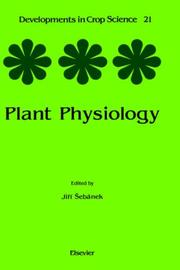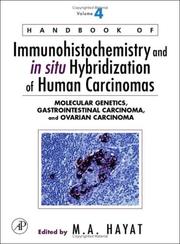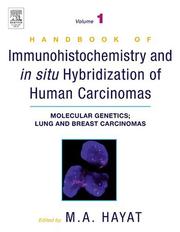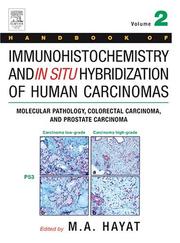| Listing 1 - 10 of 15 | << page >> |
Sort by
|
Book
ISBN: 1349113395 Year: 1990 Publisher: London : Palgrave Macmillan,
Abstract | Keywords | Export | Availability | Bookmark
 Loading...
Loading...Choose an application
- Reference Manager
- EndNote
- RefWorks (Direct export to RefWorks)
A manual that details the techniques of electrofusion and electroporation by researchers who were the first to show that the platelet membrane glycoproteins GP IIb and GP IIIa are associated in a complex which triggered interest in electrofusion.

ISBN: 0444996958 1322256659 148329188X 9780444996954 044441617X 9780444416179 Year: 1982 Publisher: New York, New York ; Amsterdam, The Netherlands : Elsevier Scientific Publishing Company,
Abstract | Keywords | Export | Availability | Bookmark
 Loading...
Loading...Choose an application
- Reference Manager
- EndNote
- RefWorks (Direct export to RefWorks)
This authoritative work has been written by a man whose career as an active wheat geneticist has spanned sixty years and has earned him a world-wide reputation. The book contains descriptions and much original data on genetical and cytogenetical findings concerning cultivated wheats and their relatives. It covers chromosomal analyses, genome analyses, ancestors of wheat, artificial synthesis of wheat, evidence of cytoplasmic inheritance and variations of wild species. The author explains how these facts and concepts have been discovered, points out the importance inherent in these discoveri
Wheat --- Plant hybridization. --- Blé --- Hybridation végétale --- Genetics. --- Breeding. --- Génétique --- Amélioration --- Hybridization, Vegetable --- Plants --- Hybridization --- Plant breeding

ISBN: 128064138X 9786610641383 0080457878 0123694027 9780123694027 Year: 2006 Publisher: Boston : Elsevier Academic Press,
Abstract | Keywords | Export | Availability | Bookmark
 Loading...
Loading...Choose an application
- Reference Manager
- EndNote
- RefWorks (Direct export to RefWorks)
Classical histology has been augmented by immunohistochemistry (the use of specific antibodies to stain particular molecular species in situ). Immunohistochemistry has allowed the identification of many more cell types than could be visualized by classical histology, particularly in the immune system and among the scattered hormone-secreting cells of the endocrine system. This book discusses all aspects of immunohistochemistry and in situ hybridization technologies and the important role they play in reaching a cancer diagnosis. It provides step-by-step instructions on the methods
Cancer --- Immunohistochemistry. --- In situ hybridization. --- Fluorescence in situ hybridization. --- Immunodiagnosis. --- FISH (Fluorescence in situ hybridization) --- Fluorescent in situ hybridization --- Fluorescence microscopy --- In situ hybridization --- Nucleic acid hybridization --- Immunohistology --- Histochemistry --- Immunochemistry --- Diagnosis --- Immunological aspects

ISBN: 1281011681 9786611011680 0080495192 0123339413 9780123339416 Year: 2004 Publisher: Amsterdam ; Boston : Elsevier Academic Press,
Abstract | Keywords | Export | Availability | Bookmark
 Loading...
Loading...Choose an application
- Reference Manager
- EndNote
- RefWorks (Direct export to RefWorks)
The various cell types have traditionally been recognized and classified according to their appearance in the light microscope following the process of fixing, processing, sectioning, and staining tissues that is known as histology. Classical histology has been augmented byimmunohistochemistry (the use of specific antibodies to stain particular molecular species in situ). Immunohistochemistry has allowed the identification of many more cell types than could be visualized by classical histology, particularly in the immune system and among the scattered hormone-secreting cells of the
Molecular genetics. --- Lungs --- Breast --- Immunohistochemistry. --- In situ hybridization. --- Cancer. --- Nucleic acid hybridization --- Immunohistology --- Histochemistry --- Immunochemistry --- Lung cancer --- Genetics --- Molecular biology

ISBN: 128101169X 9786611011697 0080495206 0123339421 9780123339423 Year: 2005 Publisher: Amsterdam ; Boston : Elsevier Academic Press,
Abstract | Keywords | Export | Availability | Bookmark
 Loading...
Loading...Choose an application
- Reference Manager
- EndNote
- RefWorks (Direct export to RefWorks)
Immunohistochemistry is the use of specific antibodies to stain particular molecular species in situ. This technique has allowed the identification of many more cell types than could be visualized by classical histology, particularly in the immune system and among the scattered hormone-secreting cells of the endocrine system, and has the potential to improve diagnosis, prognosis and therapeutic options of cancer.This book discusses all aspects of immunohistochemistry and in situ hybridization technologies and the important role they play in reaching a cancer diagnosis. It provides step
Pathology, Molecular. --- Prostate --- Rectum --- Immunochemistry. --- In situ hybridization. --- Cancer. --- Diseases. --- Nucleic acid hybridization --- Biochemistry --- Immunity --- Proctology --- Molecular pathology --- Molecular biology --- Physiology, Pathological
Book
ISBN: 3839460468 383766046X Year: 2021 Publisher: Bielefeld transcript Verlag
Abstract | Keywords | Export | Availability | Bookmark
 Loading...
Loading...Choose an application
- Reference Manager
- EndNote
- RefWorks (Direct export to RefWorks)
Wie gestalten und konstruieren Migrant*innen als Akteur*innen in globalen Bewegungsprozessen ihr Leben und ihr Selbst über territoriale Grenzen hinweg? Welche Rolle spielen digitale Kommunikationstechnologien als Brücke zwischen Herkunfts- und Migrationsland und wie kommen Musik, Theater und Film bei der Bearbeitung von Migrationserfahrungen zum Einsatz? Christina Schachtner untersucht anhand von Gesprächen mit Migrant*innen in Deutschland und Österreich die gesellschaftsverändernde Kraft von Migration. Ihre transdisziplinäre Forschung nimmt insbesondere die Mediennutzung von Migrant*innen in den Blick und umfasst soziologische, psychologische, medien- und kulturwissenschaftliche sowie geschlechtersensible Perspektiven.
Migration; Transnationalität; Hybridisierung; Hybridität; Transmigration; Transtopie; Medien; Gender; Selbstkonstruktion; Globalisierung; Interkulturalität; Kulturanthropologie; Soziologie; Transnationality; Hybridization; Hybridity; Transtopia; Media; Globalization; Interculturalism; Cultural Anthropology; Sociology --- Cultural Anthropology. --- Gender. --- Globalization. --- Hybridity. --- Hybridization. --- Interculturalism. --- Media. --- Sociology. --- Transmigration. --- Transnationality. --- Transtopia.
Book
ISBN: 0124160018 129913727X 0124159443 9780124159440 Year: 2013 Publisher: London : Academic Press an imprint of Elsevier,
Abstract | Keywords | Export | Availability | Bookmark
 Loading...
Loading...Choose an application
- Reference Manager
- EndNote
- RefWorks (Direct export to RefWorks)
In Situ Molecular Pathology and Co-Expression Analyses explains, in easy-to-understand language, simplified ways of understanding and performing in situ hybridization and immunohistochemistry tests. The book also focuses on straightforward protocols used to simultaneously detect two or more proteins/nucleic acids within intact tissue by doing co-expression analyses. The fields of in situ hybridization and immunohistochemistry have expanded rapidly due to the use of computer-based analysis. To get the most out of these automated platforms, researchers and diagnostic biomedical
Immunohistochemistry. --- Medicine. --- Pathology. --- Immunohistochemistry --- Pathology, Molecular --- Immunochemistry --- Genetic Techniques --- Histocytochemistry --- Nucleic Acid Hybridization --- Immunologic Tests --- Staining and Labeling --- Histocytological Preparation Techniques --- Immunologic Techniques --- Biochemistry --- Histology --- Laboratory Techniques and Procedures --- Histological Techniques --- Investigative Techniques --- Cytological Techniques --- Clinical Laboratory Techniques --- Diagnosis --- Chemistry --- Biological Science Disciplines --- Analytical, Diagnostic and Therapeutic Techniques and Equipment --- Anatomy --- Natural Science Disciplines --- Disciplines and Occupations --- In Situ Hybridization --- Gene Expression Profiling --- Biology --- Medicine --- Health & Biological Sciences --- Pathology --- Microbiology & Immunology --- Technique --- Pathology, Molecular. --- In situ hybridization. --- Nucleic acid hybridization --- Molecular pathology --- Molecular biology --- Physiology, Pathological --- Technique.

ISBN: 0444427694 1322256500 1483289982 9781483289984 044441617X 9780444427694 Year: 1987 Publisher: Amsterdam : New York, New York : Elsevier Science Publishers, Elsevier Science Publishing Company Inc.,
Abstract | Keywords | Export | Availability | Bookmark
 Loading...
Loading...Choose an application
- Reference Manager
- EndNote
- RefWorks (Direct export to RefWorks)
This book is a comprehensive survey of breeding principles and practices employed by sugarcane growers and researchers throughout the world. Included within its scope are important genera and species concepts, morphological information, clarification of certain generic names, a description of germplasm collection and utilization, discussion of the complex issues involved in genetic manipulation, and a summary of sugarcane improvement through breeding over the past century. The book is compiled so that information proceeds from the general to the specific.
Sugarcane --- breeding methods --- Gene pools --- Varieties --- Agronomic characters --- Selection. --- Selection --- Crossbreeding --- Hybridization --- Sugarcane. --- Saccharum officinarum --- Sugar-cane --- Energy crops --- Saccharum --- Sugar crops --- Breeding.
Book
ISBN: 1315119684 1498714544 Year: 2022 Publisher: Boca Raton : CRC Press,
Abstract | Keywords | Export | Availability | Bookmark
 Loading...
Loading...Choose an application
- Reference Manager
- EndNote
- RefWorks (Direct export to RefWorks)
This book is an extended argument for abandoning the species rank. Instead, the author proposes that the rank of "species" be replaced by a pluralistic and multi-level view. In such a view, all clades including the smallest identifiable one would be named and studied within a phylogenetic context. What are currently called "species" represent different sorts of things depending on the sort of organisms and processes being considered. This is already the case, but is not formally recognized by those scientists using the species rank in their work. Adopting a rankless taxonomy at all levels would enhance academic studies of evolution and ecology and yield practical benefits in areas of public concern such as conservation. KEY FEATURES Proposes the replacement of restrictive species concepts with a pluralistic view Suggests abandoning the formal taxonomic rank of "species" Considers zoological, botanical, and microbiological aspects of the species level Deals with practical issues such as conservation, inventories, and field guides.
Species. --- NATURE / Animals. --- Speciation (Biology) --- Biology --- Genetics --- Hybridization --- Organisms --- Animals. --- Animal kingdom --- Beasts --- Fauna --- Native animals --- Native fauna --- Wild animals --- Wildlife --- Human-animal relationships --- Zoology

ISBN: 0121852520 0121852512 1483267857 9780121852511 9780121852528 Year: 1989 Volume: 1. Publisher: San Diego, California : Academic Press,
Abstract | Keywords | Export | Availability | Bookmark
 Loading...
Loading...Choose an application
- Reference Manager
- EndNote
- RefWorks (Direct export to RefWorks)
Gene Probes
Biological techniques --- Neuropathology --- Molecular biology --- Neurobiology --- DNA probes --- Gene expression --- Neurobiologie --- Biologie moléculaire --- Sondes ADN --- Expression génique --- Technique --- Biologie moléculaire --- Expression génique --- Mammals --- Gene expression. --- Hybridization. --- Molecular cloning. --- Cloning, Molecular --- DNA cloning --- Gene cloning --- Cloning --- Genetic engineering --- Molecular genetics --- Clone cells --- Hybridisation --- Hybridism --- Breeding --- Heredity --- Mendel's law --- Genes --- Genetic regulation --- Nervous system. --- Expression
| Listing 1 - 10 of 15 | << page >> |
Sort by
|

 Search
Search Feedback
Feedback About UniCat
About UniCat  Help
Help News
News